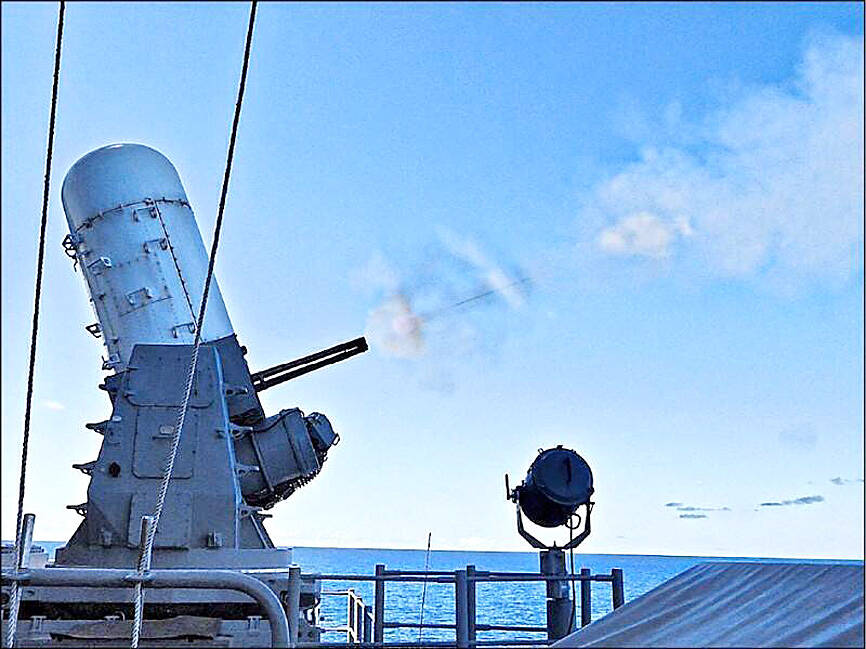The navy has installed 13 Phalanx Block 1B close-in weapons systems on its warships, increasing their defensive firepower, a defense official said on Saturday.
The systems cost the navy NT$10.16 billion (US$314.67 million), while eight additional Block 1A systems are being upgraded in the US and are expected to be delivered next year, the official said, speaking on condition of anonymity.
The Phalanx system used by Taiwan to defend its warships and key radar installations is a radar-cued gun system capable of firing 4,500 rounds a minute at targets as far away as 1.5km, the official said.

Photo: Screen grab from the navy’s Facebook page
With their superior range of engagement, rate of fire and a forward-looking infrared sensor, the Block 1B variant of the Phalanx system would boost navy ships’ defensive firepower against missiles, aircraft and small boats, he said.
The navy uses Phalanx systems to arm Keelung-class destroyers, Tuo Chiang-class frigates and Kang Ding-class frigates, among other warships that make up its fleet of principal surface combatants, he said.
The Yushan-class landing platform docks and the next-generation light frigates under construction would also be equipped with Phalanx systems, the official said.
Taiwanese warships typically have a point defense battery consisting of one or two Phalanx systems, he added.
The navy is to test the Sea Oryx Missile System, which was developed by the Chunghsan Institute of Science and Technology as a potential replacement for the Phalanx system, in live-fire exercises scheduled for later this month, he said.
The navy believes the US-made RIM-116 Rolling Airframe Missile or one of equivalent capability would be the best choice to use as point defense weapons on future warships, he added.

The US government has signed defense cooperation agreements with Japan and the Philippines to boost the deterrence capabilities of countries in the first island chain, a report by the National Security Bureau (NSB) showed. The main countries on the first island chain include the two nations and Taiwan. The bureau is to present the report at a meeting of the legislature’s Foreign Affairs and National Defense Committee tomorrow. The US military has deployed Typhon missile systems to Japan’s Yamaguchi Prefecture and Zambales province in the Philippines during their joint military exercises. It has also installed NMESIS anti-ship systems in Japan’s Okinawa

TRAGEDY STRIKES TAIPEI: The suspect died after falling off a building after he threw smoke grenades into Taipei Main Station and went on a killing spree in Zhongshan A 27-year-old suspect allegedly threw smoke grenades in Taipei Main Station and then proceeded to Zhongshan MRT Station in a random killing spree that resulted in the death of the suspect and two other civilians, and seven injured, including one in critical condition, as of press time last night. The suspect, identified as a man surnamed Chang Wen (張文), allegedly began the attack at Taipei Main Station, the Taipei Fire Department said, adding that it received a report at 5:24pm that smoke grenades had been thrown in the station. One man in his 50s was rushed to hospital after a cardiac arrest

‘WIN-WIN’: The Philippines, and central and eastern European countries are important potential drone cooperation partners, Minister of Foreign Affairs Lin Chia-lung said Minister of Foreign Affairs Lin Chia-lung (林佳龍) in an interview published yesterday confirmed that there are joint ventures between Taiwan and Poland in the drone industry. Lin made the remark in an exclusive interview with the Chinese-language Liberty Times (the Taipei Times’ sister paper). The government-backed Taiwan Excellence Drone International Business Opportunities Alliance and the Polish Chamber of Unmanned Systems on Wednesday last week signed a memorandum of understanding in Poland to develop a “non-China” supply chain for drones and work together on key technologies. Asked if Taiwan prioritized Poland among central and eastern European countries in drone collaboration, Lin

ON ALERT: Taiwan’s partners would issue warnings if China attempted to use Interpol to target Taiwanese, and the global body has mechanisms to prevent it, an official said China has stationed two to four people specializing in Taiwan affairs at its embassies in several democratic countries to monitor and harass Taiwanese, actions that the host nations would not tolerate, National Security Bureau (NSB) Director-General Tsai Ming-yen (蔡明彥) said yesterday. Tsai made the comments at a meeting of the legislature’s Foreign Affairs and National Defense Committee, which asked him and Minister of National Defense Wellington Koo (顧立雄) to report on potential conflicts in the Taiwan Strait and military preparedness. Democratic Progressive Party (DPP) Legislator Michelle Lin (林楚茵) expressed concern that Beijing has posted personnel from China’s Taiwan Affairs Office to its